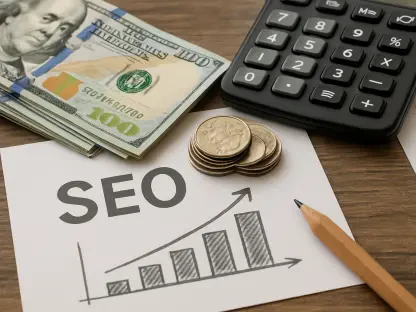In the digital age, social media has become a powerful tool across numerous industries. Anastasia Braitsik, a global expert in SEO, content marketing, and data analytics, provides her insights into how pharmaceutical companies are harnessing this tool. As social media continues to evolve, so does its impact on the marketing strategies of industries like pharma, and Anastasia sheds light on this dynamic landscape.
Can you explain how the original “ice bucket challenge” influenced social media marketing strategies in the pharma industry?
The “ice bucket challenge” was a phenomenal success that demonstrated the capability of social media to shine a spotlight on major health causes without pushing any specific products. It showed pharmaceutical companies the potential of social media for raising awareness and engaging a broad audience. This event helped them see how social platforms can create meaningful dialogue and inspire action, which is often more impactful than traditional marketing methods.
What are some examples of unconventional or unbranded marketing tactics that pharma companies can leverage on social media?
Unbranded campaigns allow pharma companies to focus on education and awareness rather than specific drug promotion. These tactics include developing content around general health topics or conditions, sharing patient stories, and fostering community support around health issues. By not mentioning specific drugs, they can circumvent certain regulatory challenges and engage more freely with audiences on platforms like Instagram and TikTok.
How might a ban on pharma TV ads, as proposed by HHS Secretary Robert F. Kennedy, impact the industry’s marketing strategies?
If a ban were to happen, it would undoubtedly push pharmaceutical companies to refocus their marketing efforts on alternative channels, with social media being a prime candidate. This shift would require a significant reevaluation of their communication strategies, using social media to target patients and healthcare providers directly more than before. It could lead to more innovative content tailored for digital platforms, leveraging their interactive features to engage users.
Why do pharma companies spend substantial amounts on TV advertising, and how might these strategies shift towards social media?
TV remains an attractive option because it reaches a large audience and allows for extensive control over messaging. However, as more individuals seek health information online, social media offers a lucrative alternative with its two-way communication capabilities. Companies will likely adapt by targeting ads towards specific demographics, creating dynamic content suitable for online interaction, and leveraging the personal touch social media offers.
What are the regulatory challenges pharma companies face when using social media for marketing purposes?
Falling under strict FDA guidelines, pharma companies must carefully navigate issues like adverse event reporting and content approval. The real-time nature of social media also brings the risk of unmoderated discussions around product safety and efficacy, which can lead to compliance issues. Rigorous internal processes for content review and approval are needed to meet compliance while staying relevant and engaging online.
How does social media create a two-way dialogue between pharma companies and patients, and what are the implications of this interaction?
Social media transforms communication from a one-sided broadcast into an ongoing conversation. It allows patients to interact with companies and each other, which can lead to improved community building and support. However, it also brings the responsibility of managing information accuracy and addressing patient concerns promptly to prevent misinformation and maintain trust.
What resources are required for pharma companies to manage social media interactions effectively?
Successful social media management demands dedicated teams skilled in digital communication and community engagement. They need the technical know-how to handle platforms, creative capabilities to produce compelling content, and legal expertise to ensure compliance with industry regulations. Additionally, robust monitoring tools are essential to track conversations and promptly address any emerging issues.
How crucial is the content review process for pharma companies, and what strategies can they use to streamline this process?
The content review process is vital given the regulatory stakes. Streamlining involves preparing content pipelines in advance, using pre-approved templates, and employing digital tools for faster review cycles. Partnering with marketing firms experienced in the pharmaceutical field can also improve efficiency, ensuring that content remains compliant and engaging.
How do companies like Pfizer utilize a multi-platform marketing strategy, and what are the strengths and weaknesses of this approach?
Pharma companies, including Pfizer, often use a single ad concept across multiple platforms to maintain consistency and manage reputational risk. While this approach is efficient, it can miss out on platform-specific engagement opportunities. Tailoring content to each platform’s unique capabilities and audience expectations might yield even more effective results.
In what ways can pharma companies use social media to boost education and disease awareness without promoting specific drugs?
By focusing on informative content about conditions, prevention, and healthy lifestyles, pharma companies can engage audiences without delving into specific drugs. This approach not only fosters education but also encourages dialogue and empowers patients to seek further consultation with healthcare providers for personalized advice.
How can social media influencers enhance disease awareness campaigns for pharma companies?
Influencers bring credibility and relatability, making complex health topics more approachable. By sharing personal stories and experiences, they can effectively raise awareness and drive conversations in a way that resonates with their followers, helping to dispel myths and encourage informed health choices.
Why is trust in social media influencers generally higher than in brands or social media platforms themselves?
Influencers are often seen as authentic individuals sharing real experiences, which builds trust among their followers. Unlike brands, they are perceived to speak from personal experience rather than corporate interest, making their endorsements feel more genuine and relatable.
How do misinformation issues on social media impact the pharma industry, especially during crises like the COVID-19 pandemic?
Misinformation can undermine public confidence, especially during health crises. The rapid spread of inaccurate information poses a significant challenge, requiring pharma companies to be proactive in delivering accurate and timely responses. Building partnerships with trusted influencers can help counter misinformation and guide the narrative positively.
How can pharma companies strategically collaborate with influencers to communicate effectively with their audiences?
Strategic collaborations involve selecting influencers who align with the company’s values and can genuinely advocate for the chosen health message. Co-creating educational content and campaigns allows these voices to authentically share insights, leading to more meaningful engagement and trust with target audiences.
Do you have any advice for our readers?
Given the increasing influence of social media, my advice is to keep informed and critically assess the health information encountered online. Engage with credible sources, and don’t hesitate to question and seek clarity on topics. As social media continues to shape health narratives, being a discerning participant is crucial.









